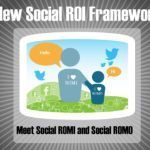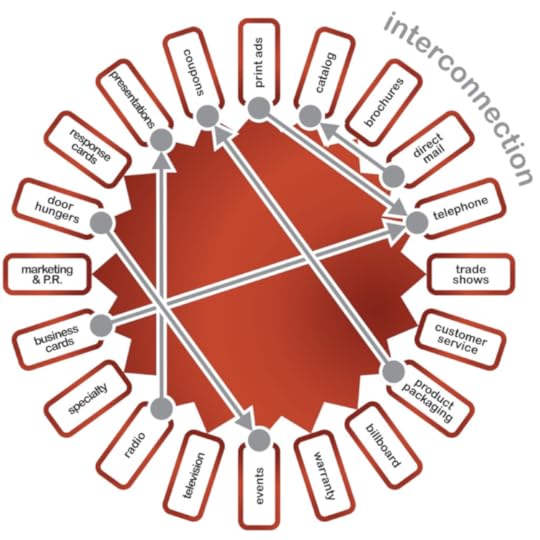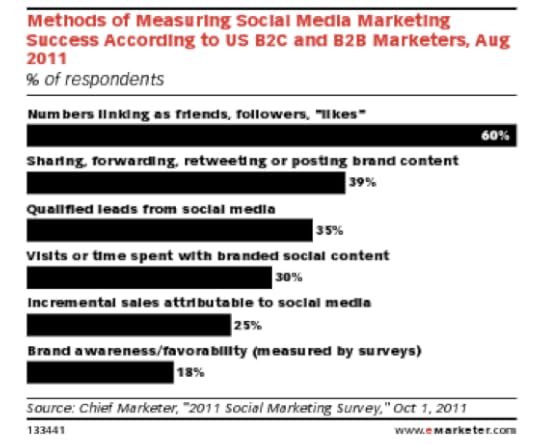Erik Qualman's Blog, page 652
October 2, 2012
The Tasti D-Lite Way: 5 Questions with BJ Emerson

 Few social marketing books are told from the brand’s perspective. The Tasti D-Lite Way: Social Media Marketing Lessons for Building Loyalty and a Brand Customers Crave chronicles the digital journey of an amazing brand as it jumps headlong into the realm of social media at a critical point in the history of the company. We sat down with co-author BJ Emerson to discuss why Tasti D-Lite is such a unique case study in anticipation of our upcoming webinar Social Media: The Tasti D-Lite Way.
Few social marketing books are told from the brand’s perspective. The Tasti D-Lite Way: Social Media Marketing Lessons for Building Loyalty and a Brand Customers Crave chronicles the digital journey of an amazing brand as it jumps headlong into the realm of social media at a critical point in the history of the company. We sat down with co-author BJ Emerson to discuss why Tasti D-Lite is such a unique case study in anticipation of our upcoming webinar Social Media: The Tasti D-Lite Way.
Why did you choose to tell the story of Tasti D-Lite?
There are some fascinating events unfolding in the world of social media as it relates to customer engagement. With consumer adoption of mobile and social technologies, new opportunities are presenting themselves daily when it comes to meeting needs and providing great experiences online. As early navigators over these last 5 years, we’ve curated some great stories and case studies. We found a great partner in McGraw-Hill to help us share what goes on behind the scenes and what it really takes to be relevant on today’s web.
Before there was an organized social business strategy for Tasti D-Lite, there were independent social communities of customers. How did Tasti D-Lite take advantage of this passionate group of users?
Demonstrating value and earning credibility within these communities takes time. Our approach started with simply listening and support, then engagement and content. We found that our participation was appreciated as a result. Many are eager to hear news and information on flavors and locations as we grow into new areas.
How does Tasti D-Lite measure social marketing success?
With more points of measurement than traditional media, each campaign needs to be engineered so that results can be measured after the fact. When clear objectives are established from the start and data points are in place, it’s not hard to determine if a particular campaign was a success.
One of the ways we define success is how well we are able to integrate the social mindset into our organization, both at the corporate office as well as throughout our franchise community. Successfully scaling our social media efforts will require involvement from both.
How can the franchise business model work with social marketing? How much autonomy does each franchise have for communicating on the social web?
As franchisor, the best thing we can do is equip our franchise network so that operators can reach their local customers where they are online. For example, centralizing but training and co-managing virtual real estate like Facebook Pages, Google Places and Foursquare venues is a way to scale while effectively stewarding the brand assets online. The relevant content required at the local level cannot easily be scaled from the top down. Local ownership meets the demand for localized content but if they don’t have the means to interact with customers online a franchisee is paralyzed.
Tasti D-Lite took advantage of a unique opportunity; its growth phase and international expansion coincided with the rise of social media. Now that social media is more established, what’s next for Tasti D-Lite?
Capturing and holding onto the heart of today’s empowered consumer is a journey requiring constant change and an intentional pursuit of relevance in the marketplace. It’s not so much about the technologies themselves that are being used, it is understanding the behavior of our customers and how we can best meet their needs and provide great experiences. This is the challenge we all face going forward.
For more insights from BJ Emerson, be sure to attend our upcoming joint webinar: Social Media: The Tasti D-Lite Way. You can also download chapter 1 of The Tasti D-Lite Way: Social Media Marketing Lessons for Building Loyalty and a Brand Customers Crave.
Mike Lewis
[image error]
September 30, 2012
How Classrooms Can Excel Using the Latest Technology and Social Media

Living in a city where there is a sea of college students, I see more technological gadgets on these young students than sometimes even on adults. They have iPads in the classroom to take notes on, read their books on, and more. However it’s not just technology that’s advancing in the classroom it’s also the acceptance and usage of social media. There are many colleges that demonstrate adaptation and skill in using social successfully to teach students. So what are the benefits of using new technology and social media? Here are three reasons why your classroom should consider the same…
iPads in the classroom to take notes on, read their books on, and more. However it’s not just technology that’s advancing in the classroom it’s also the acceptance and usage of social media. There are many colleges that demonstrate adaptation and skill in using social successfully to teach students. So what are the benefits of using new technology and social media? Here are three reasons why your classroom should consider the same…
1. Use the technology and Networks They Already Use and Know
Students are already posting on Facebook, reading blogs on Tumblr, tweeting their favorite things on Twitter, and pinning what they love on Pinterest. They know how to use the sites well, and they use it often. Make part of the class participation online participation. It helps those who are creative but perhaps shy in class. For example homework can include keeping a Tumblr blog about a topic which students can comment on and share ideas on. Or if it’s a photography class, how about utilizing Instagram or again Tumblr to host that content. Tip: find the networks that work best for your lesson content (and students).
2. Integrate With Lesson Plans and Learnings

The infographic demonstrates that professors and teachers are already adapting, and even shows the networks where they can utilize to make their efforts more fruitful with their students. It’s not just about using Facebook and Twitter, but realizing that you can create a wiki for the class and online discussion, and/or pin daily findings on a Pinterest board. There are numerous ways to take advantage, it’s about creating the lesson plan that works for you and your students creativity and desire to engage with the content in places they love interacting. Some students may be hesitant to use their own profiles that already exist – so perhaps create new ones just for class or a location where they can all contribute.
3. Continue and Extend the Conversation Past the Classroom
It is a great opportunity to extend conversation past the classroom. Take the offline, online. For example creating a hashtag for the classroom to corral conversation and extend a topic that was discussed in class, after class has ended. It keeps the students thinking, searching, reading, and interacting with the content.
Last Tip: Remember to keep content and tools fresh. As we all are well aware, tools and social networks, and apps change, update, and pop up daily. It is tough to keep up but we have to. Perhaps utilize students who work for the school to keep up on the research regarding what’s the latest to help keep lesson plans fresh.
Further Reading:
http://www.mediabistro.com/alltwitter/teachers-guide-social-media_b25989
http://www.readwriteweb.com/archives/for-social-media-in-the-classroom-to-work-instructors-need-best-practices.php
http://www.zdnet.com/blog/igeneration/the-pros-and-cons-of-social-media-classrooms/15132
http://www.usatoday.com/news/education/story/2012-03-04/facebook-twitter-social-media-classroom/53358382/1
[image error]
September 25, 2012
On the Horizon for Marketers? Adoption of New Platforms to Help Manage Social Data

In our State of Social Marketing Report 2012, which surveyed over 450 marketers from a wide variety of industries, company sizes and levels of social sophistication, several key themes emerged. One theme speaks to what we can expect from social marketers in the near future.
With the explosion of social data, and to the extent to which this data can be layered on top of known customer and prospect data, expect to see a rise in social CRMs. Social CRM systems will be increasingly used to integrate social data with traditional marketing and sales data to allow marketers to close the loop on their integrated marketing efforts. Currently, adoption of social CRMs is higher among advanced brands than novice brands, but expect to see this number increase across the board in 2013 and beyond.
 But, it’s not just social CRM that has seen growth. Companies are also turning to other social technologies to help transition their businesses into social enterprises. Among these platforms, various community platforms are used by 65% of the companies represented in this report. There is a growing interest in social technologies like collaboration platforms (33%), social commerce platforms (23%) and innovation platforms (15%).
But, it’s not just social CRM that has seen growth. Companies are also turning to other social technologies to help transition their businesses into social enterprises. Among these platforms, various community platforms are used by 65% of the companies represented in this report. There is a growing interest in social technologies like collaboration platforms (33%), social commerce platforms (23%) and innovation platforms (15%).
For a detailed set of findings on this topic and others, including top marketing challenges in 2012, download the full white paper, The State of Social Marketing Report: 7 Major Findings & In-Depth Analysis.
Marketers, do you agree? Have you implemented a social CRM yet? Sound off on Twitter at @awarenessinc.
[image error]
September 20, 2012
A New Social ROI Framework (Infographic)

Marketers across the globe are trying to answer the most important question about what they do – namely, can they quantify the value they provide to the business and show that the funds and resources invested in marketing, including social marketing, do indeed pay back? Our State of Social Media Marketing Report confirms that measuring social marketing ROI is the leading challenge for marketers, as indicated by 57% of respondents.
To address the social ROI question, Awareness developed a new framework for measuring social marketing value. We posit that social marketing value has two sides – overall social marketing contributions to the business over time (usually measured year-over year), and specific social marketing contributions to customer engagement and sales (usually campaign-based and short-term).
For more about the new social ROI framework, download the full free white paper. Marketers, how have you measured campaign-based and overall success in the past?
Mike Lewis
[image error]
September 18, 2012
Fusion Marketing – 5 Questions with Lon Safko

Social marketing is only part of a healthy marketing mix. If you’re still stuck looking at social media as a standalone technology, you’ll soon be left behind. The Fusion Marketing Bible, Lon Safko’s upcoming book, takes on this challenge, integrating 6,000 years of traditional marketing, the exciting digital marketing tools of the Internet age, and social media into one seamless tool set to help you achieve any goals you set. In anticipation of our upcoming webinar, Fusion Marketing – It’s What’s Next!, we sat down with Lon for some Q & A.
What exactly is “Fusion Marketing”?
We all have trouble wrapping our brains around all of the marketing needed to be successful in business today. Fusion Marketing fuses traditional, digital, and social media into one simple marketing platform that increases revenue. Fusion represents a revolutionary technique for analyzing every possible traditional marketing tool to find the tools with the greatest ROI for your company. Next, it shows you how to develop and choose extremely effective digital / social media tools. Finally, Fusion Marketing takes you through a process of completely “fusing” all of these tools together into one amazing, effective, and custom marketing plan.
How can businesses benefit from Fusion Marketing?
Fusion Marketing allows us to see the big picture of our marketing efforts and to see connections we never saw before. By leveraging these interconnections, you can see exponential returns on your marketing dollars without spending a cent more.
What is this “patent pending” marketing tool that you invented called the Safko Wheel?
The Safko Wheel is a marketing tool that easily allows you to place up to 40 different forms of marketing around the Wheel and see all possibilities at a glance. By placing all of your marketing tools around the Safko Wheel, you can begin to immediately see connections you never would have seen before. Connecting one tool on the Wheel to another, you can leverage the best practices of each of those tools together.
The Wheel also allows you to effectively develop all of your strategies and goals. By placing a goal or objective in the center of the Wheel and connecting it one-by-one to all of the custom tools around the Wheel, your most effective Tactics will emerge. By combining those Tactics with the Tools that satisfy your Objectives, you will develop killer strategies!
How can a company benefit from your invention, “Fractal Fusion” Marketing?
Fractal Fusion take the concept of Fusion Marketing combined with the Safko Wheel and allows businesses to selectively choose just one marketing tool and drill down into that tool to identify even more opportunities than previously imagined. For example, what if you chose “social networks,” just one tool out of more than 40 to choose from, and placed it in the center of the Safko Wheel? This would make you look at the top 20 social networks in the world.
Can you name the top 20 social networks? No? Google it! Then place them around the Safko Wheel. Do you notice how many you don’t have a profile on? How many can you “fuse”? Are you using Facebook to drive people to your LinkedIn profile? Can people look at your LinkedIn profile and simply click to see your Facebook timeline?
In your book, you actually redefined “strategy”. Can you elaborate?
Everyone thinks they know the definition of “strategy” until you ask them. I studied this term and found there was no effective answer. Strategy isn’t a thing; it’s the combined outcome of defining several objectives, selecting the proper tools, and connecting those tools to that objective to create effective tactics.
Start with creating several solid objectives, such as “I want to increase my email list” or “I want to drive more traffic to a specific product web page”. Place one Objective in the center of the Safko Wheel and ask yourself “How can I use each tool on the Wheel to achieve that objective?” or “How can I use Print Ads to increase my email effectiveness?” or “How can I use my business cards to grow my email list?”. Move around the Safko Wheel asking that of every tool. Collect your answers to create a killer custom list of strategies that works perfectly for your company!
For more insights from Lon Safko, be sure to attend our upcoming joint webinar: Fusion Marketing – It’s What’s Next!. You can also download chapter 1 of The Fusion Marketing Bible here!
[image error]
September 17, 2012
How Your Business can Benefit from RealTime Ads
Have you ever noticed that some ads on Google seem to contain details about the product advertised that would be impossible to keep relevant on a day-to-day basis? Well, it’s not just some fluke or coincidence. There are systems at work out there making sure that every product an advertiser has in stock is automatically advertised and has the right price and a direct link for easy buying.
If you’re a marketer who wants to make sure that you deliver ads like these to consumers, getting them to the right people at the right time, then you should know that this is something you can’t do by yourself. You need a good ad system. Enter RealTime Ads.
Keybroker’s RealTime Ads system is the perfect way to close the deal as an online marketer. The real key here is in the way the ads are automated. Working with a retailer’s inventory database, RealTime Ads collects a slew of pertinent information about products, prices, availability, and other powerful and useful statistics.
In short, the ads you create are updated automatically based on any one of a number of changes in your inventory database.
How RealTime Ads Work
Let’s say that you’re a big player in the affiliate field and you have multiple sites and multiple ad campaigns going. Well, the ads you spend so much time creating are representative of what your business is about – accurate, informative product ads which compel people to actually click through and ultimately make a purchase.
But what if the price changes or an item goes out of stock?
You will end up with a wasted ad or, worse, a frustrated customer if the ad you’re presenting is outdated. With RealTime Ads, however, you’re always presenting the most accurate and the most up-to-date information out there. That feature alone gives you a huge leg up on the competition in terms of enticing buyers. Keybroker’s service is all about converting sales.
Since you most likely already know how ad management tools work, we can save the overly technical stuff. This article is about explaining the real benefits of RealTime Ads in layman’s terms. So, to that end, let’s talk about some of the great benefits of this system.
RealTime Ads comes with data feed integration support, dynamic campaign structure generation, ad content updated based on stock information from retailers, a business rules-based optimization feature, advanced product filtering features, and a proactive bid management feature that allows you to receive the upmost value for your investment.
To sum it up, working with Keybroker and RealTime Ads enables you to deliver always up-to-date ads to the right people at the right time.
Users are far more likely to find your ads, and they’re far more likely to find your ads worthy of clicking through and ultimately make a purchase.
[image error]
September 14, 2012
4 Reasons Why Social Media Will Make Me a TV Junkie This Fall

Originally posted on the Likeable blog
It’s official. I’m going to be glued to my couch this fall.
Since I work in social media, it’s no surprise that my eyes hardly ever leave my computer screen: I am flooded with hundreds of posts, tweets, pins, etc. day in and day out. With the amount of time I spend on social media sites, there’s no way I could miss all the buzz around the Fall 2012 television lineup. It wasn’t until recently I discovered how smart some of these shows’ marketing tactics are. You see, the marketing folks over at major television networks noticed 4 qualities about me, the social media nerd, that they could tap into. Let’s see exactly how they did that:
1) I’m incredibly nosey. If I’m being completely honest with myself, the main reason I use Facebook and Twitter is because I want to spy on people I know: my friends, my family members, my college classmates, that girl that was mean to me in high school, that guy I haven’t seen since 5th grade, my old boss, etc. Like any true social media nerd, I am an information sponge and have a need to learn much as I can as fast as I can.
This is why I’m a sucker for spoilers and exclusive content. To promote the new season, the people behind the New Girl series created the Douchebag Jar (this is a reference from the show, in case you were wondering). The Douchebag Jar provided fans with exclusive content if they “filled up the jar” with Facebook shares. This exclusive content consists of videos from the cast, photos, and more. This type of content is the perfect bait for social media nerds such as myself.
[image error]
Also, if Ryan Murphy tweets out one more ambiguous spoiler for Season 4 of Glee I might die of anticipation.
Who will win THE GLEE PROJECT 2? Writing such a great role for the winner! And just wait until you see who they are dating…
— Ryan Murphy (@MrRPMurphy) August 14, 2012
2) I want to be special. The beauty of social media is that it gives a voice to even the quietest people. Through various methods of engagement, it also provides the user with validation that their voice is being heard. Everyone wants to be recognized and feel like their opinion matters.
Last night’s Bachelor Pad finale made me realize that reality TV does this very well. While the show was airing, the Bachelor Pad cast was following the hashtag #BachelorPad and tweeting their reactions. When the big surprise ending occurred, the cast members were there to answer fan questions, complaints, and opinions. It made all of us tweeting along feel like we were a part of the conversation and that our opinions were being heard by the people who matter (come on, even D-list celebs matter a little bit… right?).
3) I want to be influential. Not only do I want my voice heard, but I want to feel like I’m making an impact. I want to know that other people are not only listening to my thoughts, but also taking action upon them. I want to make a difference.
America’s Next Top Model does a great job of showing how your social media voice can go a long way. This cycle, ANTM is determining the model that gets eliminated each week based on a numeric grading system: each of the judges give a score from 1-10 and this score is combined with a “social media score.” All of the photos from this cycle were put up online and fans were asked to “like” their favorite photos and leave comments or submit videos with their feedback and score. During the show, a select few videos and comments are shared on television. Not only are fans able to impact who gets eliminated each week, but they’re also given the opportunity to be featured on a national television show.
[image error]
Fans also had an impact on the upcoming season of Dancing With The Stars. Since this is an All-Star season, ABC is bringing back a few of the show’s former contestants to once again compete for the mirrorball trophy. ABC selected 12 contestants, but let the fans decide on contestant #13.
4) I have major FOMO. I use social media as a communication tool. I use it to keep in touch with friends and to tell them what I’m doing, where I’m going, what I’m thinking, and, most relevant to this blog post, what I’m watching. If I see that 10 of my friends “like” How I Met Your Mother on Facebook, it’s likely that I will “like” it too. If I see 3 of my friends tweeting at each other about the latest episode of True Blood, chances are I’m going to want to get in on that conversation. People are highly influenced by what their friends recommend, which is why social media is the perfect tool for television networks looking to promote their shows.
What shows are you most looking forward to watching this fall?
[image error]
Is Your Business Social Media Savvy?

 Your small business is not quite firing on all cylinders, leaving you wondering where the alterations need to be.
Your small business is not quite firing on all cylinders, leaving you wondering where the alterations need to be.
Could it be your customer service? Perhaps your products are not up to speed with the needs of today’s customers? Lastly, are you not investing the time and energy into a prudent social media campaign in order to promote your business?
In the event the latter is the problem, you might end up kicking yourself in knowing that it can be a rather easy fix.
Does Your ROI Impact Social Media Efforts?
For too many business leaders, their lack of attention to properly using social media to promote their companies is more commonplace than you might think. One of the commonly heard excuses is that they have trouble seeing a return on investment (ROI), therefore social media is just not worth their effort.
As it turns out, a properly engaged social media campaign by even the smallest of businesses can yield a number of positive results.
Among the reasons to invest the time and effort into social media:
* Zero in on social networks – Have you met the company exec that thinks it is a good idea to be involved with countless social networks? While you can applaud his or her enthusiasm for being out there so to speak, are they really on top of things? Wouldn’t it be better to devote your company’s energy to one or two sites, such as a Facebook fan page and a Twitter feed? It doesn’t mean you can’t put your company out there on several different sites, but choose the ones you feel will of most benefit to your company, then give them 100 percent. Trying to be too many things for too many people never did a business good;
* Engage consumers – Does your company have a social network presence such as a Twitter or Facebook page, yet does little to update them? For too many companies, they start out with good intentions, but the social media efforts dwindle over time. As a result, people lost interest, do not come back to the sites, and in fact oftentimes move on to the competition’s pages. If you have a social media presence, you NEED to keep it updated regularly. Along with keeping the customer interest up, updating your social media venues often is also important from a search engine standpoint;
* Cut down on advertising – With the state of the economy influx these days, it is not uncommon for more businesses to be slashing their advertising budgets. As a result, wouldn’t some free advertising suit a business owner just fine? When using social media, your business can get loads of free advertising day in and out. As an example, say you own an insurance agency and you have some new products to offer, but are hesitant to spend big dollars advertising them on the radio, television or publications. A little push on social media is a great way to spread the word and avoid the costs. Get the conversation started on your Facebook or Twitter feed, be prepared to respond to current or potential customer questions, and promote your products with links back to your preferred website landing pages;
* Go where the action is – Like any smart business owner knows, much of what has to do with running a successful business is being in the right place at the right time. Millions and millions of consumers turn to the Internet to browse and purchase various goods and services these days, and that trend doesn’t appear to be changing anytime soon. So, if your business is dropping the ball when it comes to social media activism, you’re only hurting your company and your wallet. When you are active on Facebook, Twitter, Google+ or any of the other notable social media venues, you stand a much better chance of landing additional business. You can also be viewed as an authority and a business that is up to speed on today’s social media revolution by being engaged. Let’s face it, the days of potential customers walking into your office to do business for the first time are not what they once were; having a social media presence gives you a good shot of landing that customer not long after they turn on their computer.
If you have yet to find social media working for your company, it is never too late to review what you are or are not doing, focus in on a strategy, and then get social.
In the event you choose not to be social, those current and potential customers will find a business that is.
Photo credit: bigpicturedigital.com
[image error]
September 13, 2012
3 Digital Marketing Trends To Watch in 2012 and Beyond

Chances are on any given workday, marketers take advantage of a social feature, channel, tactic, or strategy that didn’t exist 12 months ago. An accelerated rate of change has always been a hallmark of social marketing, and with this in mind, eMarketer published a study in this area, Top Digital Trends for 2012. It explores digital marketing trends in 2012 and beyond, and predicts dramatic industry changes as both the hardware and software platforms of choice shift in favor of mobile devices, social media sites, and dynamic content. I was particularly struck by three key ideas:
Companies are no longer satisfied with standard social media success metrics
Magnetic content allows companies to succeed in the social and digital spaces
2012 will see a dramatic increase in Smartphone and tablet users, as well as an increase in online video consumption
A shift in social media metrics
When marketers first adopted social media, success was generally measured as volume of amassed friends, followers, and ‘Likes’. While this had been the prevailing notion of success, companies no longer feel satisfied with those metrics.
Image 1: Marketers believe social media will eventually provide ROI, but struggle to measure currently.
According to a Marketing Sherpa survey, only 20% of marketers thought social marketing produced ROI in 2011. This low number makes sense; only 41% of marketers could produce ROI figures at all according to The State of Social Media 2011 survey by Econsultancy. Of marketers surveyed, fewer than 10% could track ROI for the time and resources spent on social media efforts. However, the majority of marketers still believe that social marketing can produce ROI, which points to a need for more meaningful social analytics, and more robust tools to track key metrics.
Image 2: Some marketers are measuring more strategic metrics such as sharing of content, generating qualified leads, and earning incremental sales through the use of social media.
The importance of magnetic content
In addition to a shift in metrics, prevailing methods for capturing attention have also changed. According to eMarketer, more marketers are realizing that in order to succeed, interruptive advertising can no longer serve as the dominant method for attracting fans.
Instead of spending staggering sums on banner ads and other interruptive media, companies now place a greater emphasis on creating magnetic content that provides inherent value to consumers. This content acts to supplement paid media by increasing positive brand awareness, creating a connection with consumers, and fostering lead generation through collection of consumer information in return for valuable content.
Macy’s, for example, provides a fantastic example of how to successfully create magnetic content. In 2011, Macy’s launched a web video series called “Wendy”, a modern take on Peter Pan. Featuring short episodes and high production value, costs were low and viewers could watch the series without a significant time investment. Each episode begins with a “presented by Macy’s” banner and the characters dress in Macy’s clothing, but otherwise the shows are free from overt promotion.
Image 3: Macy’s produced a mini TV series that led to hundreds of thousands of impressions.
Marketing this content via TV, social media, and branded websites, Macy’s generated cost effective interest in their program, getting 82,000-200,000 views per episode. “Wendy” created hundreds of thousands of non-interruptive brand impressions for Macy’s by making customers want to engage with their content.
The rise of smartphones, tablets and online video consumers
2012 marks another year of increased smartphone and tablet adoption, as well as increased viewership of online videos. eMarketer’s study predicts that almost half of all mobile phone users will own smartphones, and almost a quarter of internet users will own tablets by the end of 2012.
2012 and beyond
As we look to 2013 and beyond, it’s clear that companies embracing these changes will succeed as they create valuable content, invest more in understanding their customers, and improve their social ROI measurements. What are your predictions for what’s going to shape marketing in the next year? You can also consult the 2012 Social Media and New Marketing Predictions report we published at the beginning of the year. Some of the best minds in our industry like David Meerman Scott, Brian Solis, Erik Qualman, Paul Gillin, CC Chapman, and Steve Rubel, shared their thoughts on what’s to come.
Looking forward to continuing the discussion on Twitter.
[image error]
September 11, 2012
State of Social Media Marketing: Updated Report on Top Areas For Social Marketing Investment and Greatest Social Marketing Challenges into 2013

[image error]We are pleased to share the findings from our semi-annual report on The State of Social Marketing Report: 7 Major Findings & In-Depth Analysis. Awareness surveyed over 450 marketers from a wide cross-section of industries, company sizes and experience with social marketing. Our semi-annual State of Social Media Marketing report includes insights from both those leading the efforts at the management and C-level, as well as a number of business leaders who are helping to bridge the social gap within their enterprises.
Here is a taste of the top-level findings analyzed in detail within the report:
Misalignment Between Business Objectives, Measurement Methodologies and Social Marketing Investment:
Although marketers agree that they need to drive higher customer engagement and revenues with social marketing, only 47% of them actually measure what they do and invest in what matters. The majority of social marketers (66%) still spend time and effort growing the number of social fans and followers or creating and publishing content (56%), while only 35% are focused specifically on integration between social marketing and the rest of the organization.
Social Marketers Are Starting to Measure What Matters
Social marketers are starting to track different aspects of the value they are driving – such as brand’s effectiveness in social, customer engagement, and revenue generation. To measure revenue generation, marketers look to:
New customers coming from social, as reported by 63% of respondents; new leads by 60%
Sales driven from social (59%)
Only 41% report having individual social profiles for their fans and followers,
Marketers Are Yet to Tap into the True Potential of Social
In a finding that mirrors the recent McKinsey study, few companies report using key enabling technologies such as social CRM, which can help make sense of their social following, segment and prioritize it and target their communications for business results.
Social CRM: Slow Adoption But on the Rise
Only 16% of marketers who responded to the survey are currently using a Social CRM system, while another 21% plan to by this year’s end. Social CRMs, when adopted more widely, will be used to integrate social prospect and customer data with traditional sales and marketing data. This will provide a much-needed layer of insights that will help marketers be more effective and efficient in the social age. Socially mature brands are adopting Social CRM at a higher rate- brands with a social marketing budget of over $100,000 have a Social CRM adoption rate of 44%, with an additional 26% who plan to use such a system by the end of 2012.
Social Marketing Budgets and Resources Quite Insufficient to Drive Value
54% of marketers surveyed indicate they do not have an allocated budget for social marketing, and are solely relying on human resources. With no money or resources behind them, most social marketing initiatives remain small, siloed, with little to no direct impact on key business drivers such as leads and sales.
The ‘State of Social Marketing Report: 7 Major Findings & In-Depth Analysis’ contains additional insights on top social marketing investment areas, top challenges for 2012, top social media platforms used today, the rise of social CRMs, along with a fun section revealing some of marketers’ most admired brands. You can also compare these results to those culled from our January 2012 State of Social Media Marketing report.
We welcome your thoughts, reactions and feedback. Let us know how the insights and findings presented in the State of Social Media Marketing report will help shape your thinking as we prepare for 2013. Don’t hesitate to ask us the tough questions –we want to provide insights into best practices, successes, and notable trends to help you, social marketers, do more and do better.
Mike Lewis
[image error]








